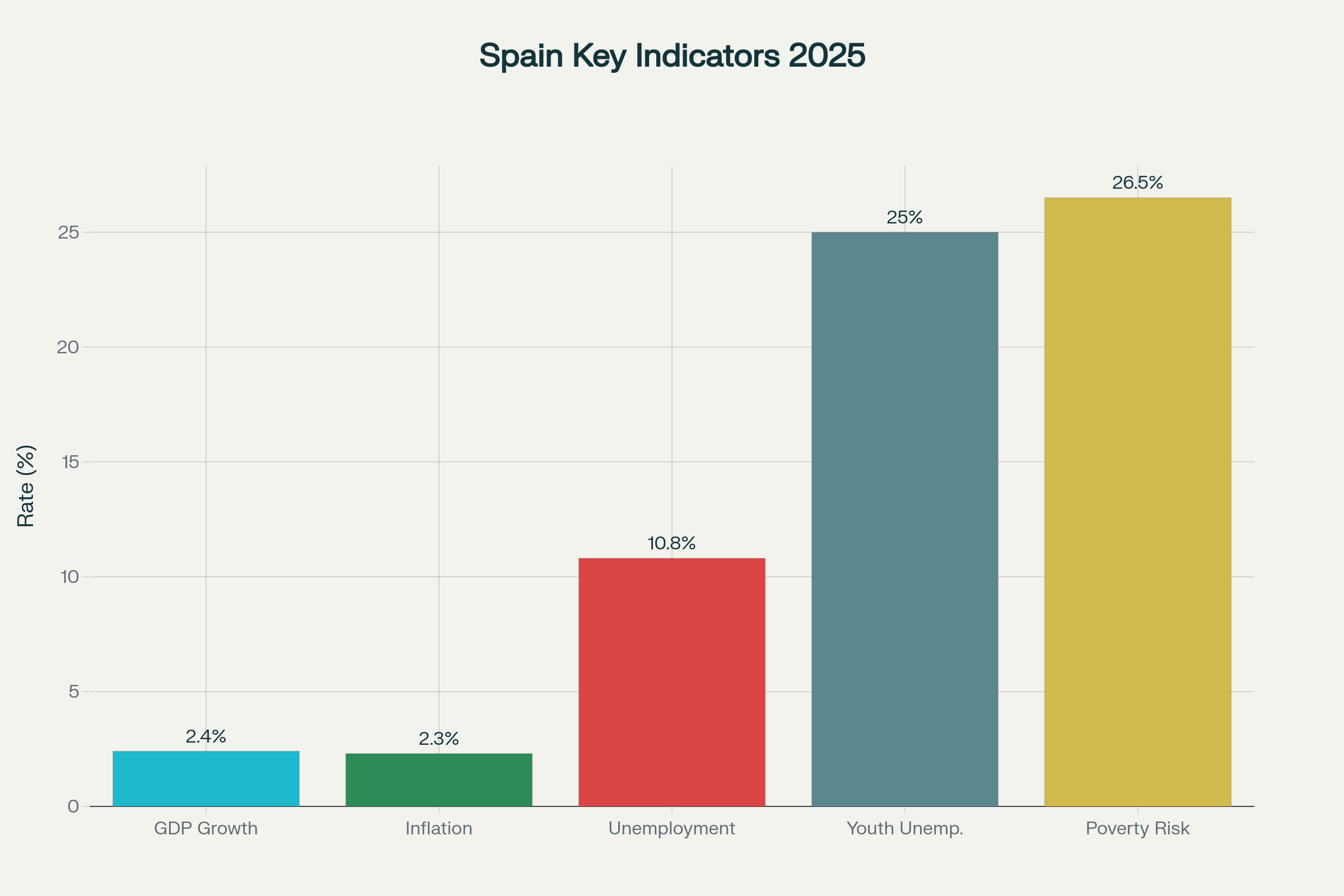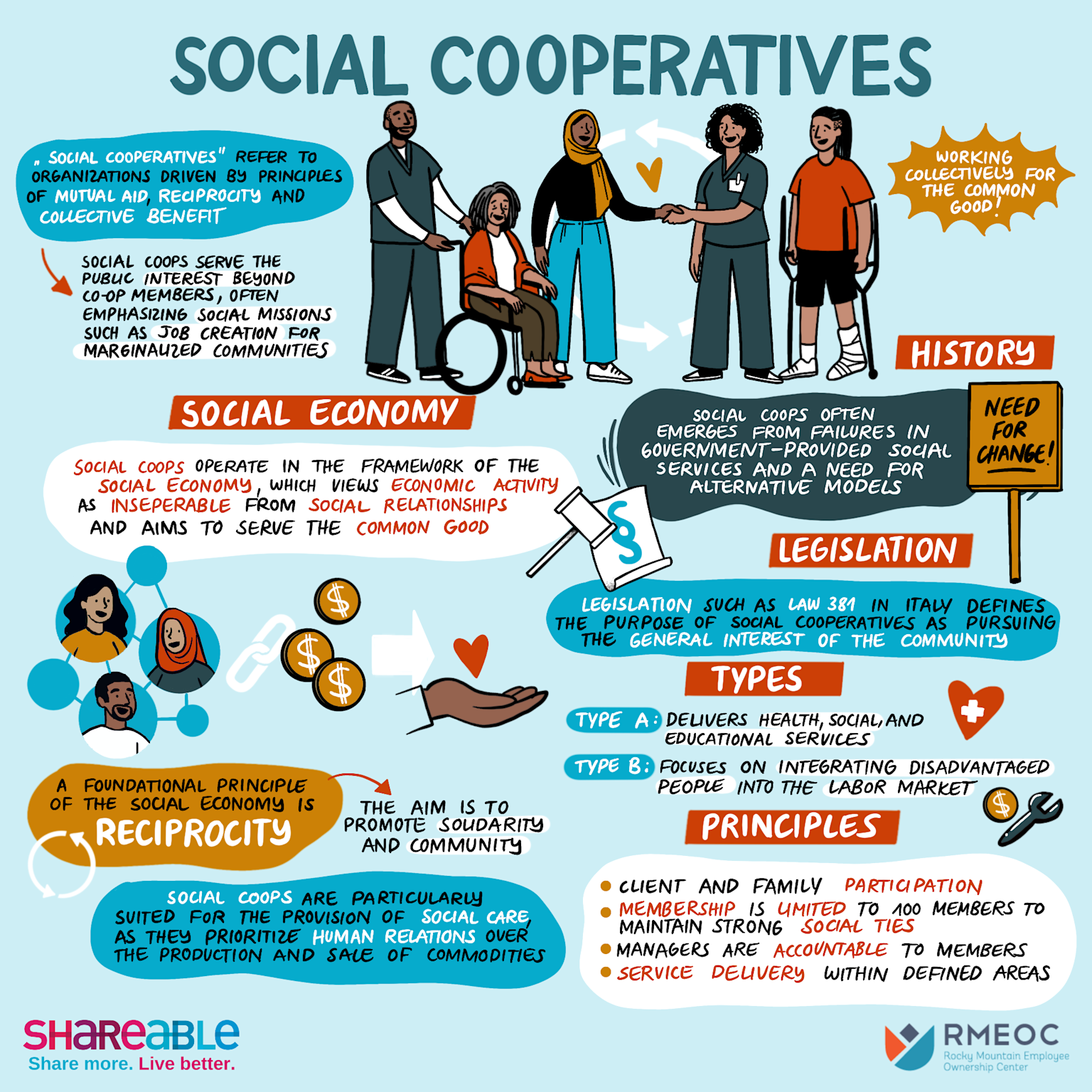Country research: Spain
Homepage " Country research " Spain
The content reflects the results of Perplexity's research and analysis and does not represent an expression of opinion by Gradido. They are intended to provide information and stimulate further discussion.
Spain & Gradido - Comprehensive research dossier for a new economic future
The Spanish economy shows remarkable resilience in 2025 despite global challenges, with a projected GDP growth of 2.4%, while facing structural social and economic inequalities. This detailed analysis explores Spain's potential for implementing alternative economic models such as Gradido and highlights the opportunities and challenges of a public good-oriented transformation.

Spain's current economic, social and political situation
Economic stability in the face of ongoing challenges
The Spanish economy is in a paradoxical situation in 2025: on the one hand, the country is experiencing solid economic growth of 2.4%, significantly outperforming the EU average, while on the other hand it is struggling with structural problems that make sustainable development difficult. With a GDP per capita of USD 36,190, Spain has even overtaken Japan (USD 33,960), which underlines the dynamism of the Spanish economy.caixabankresearch+2
Growth is mainly driven by the robust service sector, particularly tourism and highly skilled services. Although unemployment remains the highest in the OECD at 10.8% in May 2025, it shows a continuous downward trend. It is particularly noteworthy that Spain is one of the few large OECD countries to continue to reduce its unemployment rate in 2025.caixabankresearch
Political instability and corruption problems
Spain's political landscape is characterized by considerable instability. Pedro Sánchez's government is under increasing pressure due to several corruption scandals involving the ruling Socialist Party. These scandals have led to major protests, with tens of thousands of people demanding the resignation of the prime minister.oecd+1
In response to the ongoing allegations of corruption, Sánchez announced a comprehensive state plan to combat corruption in July 2025, which provides for the creation of an independent public integrity authority and the introduction of AI applications to detect corruption in public tenders.bbvaresearch
Urgent structural challenges
Spain's most urgent challenges include:
Low productivityHourly productivity is 10-15% below the Eurozone averageimf
High national debt: At 100.9% of GDP in 2025, the debt burden remains vulnerablesantander
Demographic changeAgeing population puts pressure on pension systems and reduces growth potential
Climate change and water stress: Environmental problems threaten agricultural productivity and require massive investment
Inequality and wealth distribution in Spain
Extreme concentration of wealth
Spain is one of the most unequal countries in Europe. The distribution of wealth shows dramatic disparities: The richest 1% of the population controls 26-27% of total wealth, while the top 10% own almost 60% of national wealth. In contrast, the bottom half of the population only owns around 7% of total wealth.bbvaresearch+1
The Gini coefficient for wealth is 71.3, which is significantly higher than in other European countries. This concentration has increased in recent years, with Madrid standing out as the region with the highest average household wealth (€687,000), followed by the Balearic Islands (€477,000) and Catalonia (€434,000).bbvaresearch
Regional inequalities
The regional disparities in Spain are considerable. Northern Spain generally shows higher levels of prosperity than the south, although the differences in GDP per capita between the richest and poorest regions are considerable. The poorest regions, such as Extremadura and Castilla-La Mancha, not only have lower average incomes, but also less wealth inequality, which is paradoxically due to the lower general level of prosperity.economy-finance.europa

Disadvantaged population groups
Particularly affected by poverty and social exclusion are:
Teenagers: 26% of young people from low-income households drop out of school early compared to only 5% from more affluent familiescaixabankresearch
Migrants: Non-EU migrants in particular have an increased risk of povertyeuronews
Child poverty: 27% of children and young people live in households at risk of povertyimf
Working Poor13% of full-time employees live in poverty despite working - the second highest figure in the EUimf
Labor migration and precarious employment
Migration flows and policy
Spain has introduced a new migration regulation (GECCO regulation) in 2025 to facilitate seasonal and circular migration. The country acts as both a destination and origin country for migration, with around 5.4 million immigrants living in Spain, of which over 40% are part of the active population.oecd+1
The largest groups of migrants come from Latin American countries (Peru, Venezuela, Colombia, Ecuador) due to their common language area and from North African countries (Morocco, Mauritania) due to their geographical proximity.tradingeconomics
Seasonality and precariousness
The Spanish labour market is heavily influenced by seasonal employment, particularly in agriculture and tourism. The GECCO system allows seasonal workers to work in Spain for up to nine months a year before they have to return to their country of origin. Although this regulation creates legal employment opportunities, it also perpetuates precarious employment relationships.oecd
Social consequences of labor precarity
High youth unemployment and precarious employment lead to delayed self-employment: the average age of emancipation is over 30. This has far-reaching demographic and social consequences, as young people have to postpone their life plans due to economic uncertainty.focus-economics
Corruption, clientelism and institutional challenges
Current corruption scandals
In 2025, Spanish politics is shaken by several high-profile corruption scandals that undermine trust in democratic institutions. These scandals not only affect individual politicians, but raise systematic questions about political integrity.oecd+1
Effects on social development
Corruption and political instability have several negative effects:
Loss of confidence: Citizens' trust in public institutions is dwindling
Investment uncertainty: Companies are reluctant to make long-term investments
Social fragmentationPolitical polarization reinforces social divisions
Inefficient allocation of resourcesCorruption leads to suboptimal public investments
Measures to combat corruption
The government has presented an ambitious anti-corruption plan for 2025, which comprises five pillars and was developed in collaboration with the OECD. Among other things, this plan provides for the creation of an independent integrity authority and the increased use of digital technologies.bbvaresearch
Cultural strengths and social cohesion
Family as a cornerstone of society
Spanish society is characterized by exceptionally strong family ties. Family is seen as a guarantee of security, honesty, respect and love. These values manifest themselves in practical aspects of everyday life:wid+1
Multigenerational households: Several generations often live under one roof or in close proximity
Family support systemsFamilies offer both emotional and financial support
Respect for older people: Older people enjoy a high social standing and are involved in important decisions

Community orientation and neighborhood
The concept of "vecindad" (neighborhood solidarity) is deeply rooted in Spanish culture. Neighborhoods have strong identities and people actively engage in social activities and support each other. This community orientation can be seen in:statista
Shared meals: The tradition of the "sobremesa" - lingering at the table after the meal for conversation
Local festivals and traditions: Community celebrations strengthen social cohesion
Mutual helpNeighbors support each other with everyday challenges
Regional identities and linguistic diversity
Spain is characterized by strong regional identities. The 17 autonomous communities have their own cultural traditions and, in some cases, their own languages (Catalan, Galician, Basque, Valencian). This diversity represents both a strength and a challenge, as it increases social wealth but can also make central political solutions more difficult.wid
Education and training situation
Structural problems in the education system
The Spanish education system is struggling with considerable challenges that perpetuate social inequalities. Early school leaving is 13.6%, four percentage points above the EU average. The correlation between socio-economic background and educational success is particularly alarming: while only 5% of young people from wealthy families leave school early, the figure for low-income households is 26%.caixabankresearch
Regional educational disparities
The decentralized education system leads to considerable regional differences in quality and facilities. Disadvantaged regions such as Andalusia or Extremadura often have poorer educational infrastructures and fewer resources for individualized support.oecd
Innovative educational initiatives
Despite the challenges, there are some remarkable success stories. The "Fantasy Library" in Seville's poorest district, Los Tres Mil Viviendas, won a national prize for promoting reading skills among disadvantaged children. Projects like this show that creative approaches can achieve educational success even in difficult environments.bertelsmann foundation
Healthcare system and social security
Universal healthcare system with regional differences
The Spanish healthcare system (Sistema Nacional de Salud) is considered one of the best in the world and offers almost universal coverage. It is mainly financed by taxes and offers free access to basic medical care. The life expectancy of 83.5 years proves the effectiveness of the system.gateway.euro.who+1

Challenges in healthcare provision
Despite the good overall rating, there are problems:
Regional differences in qualityDecentralized management leads to different service standards
Waiting timesAlthough shorter than in other countries, there are sometimes longer waiting times for special treatments
Care work: The burden of caring for the elderly falls mainly on families, especially women
Social safety nets
The Spanish social system includes various support measures, including the basic income for the needy (Ingreso Mínimo Vital) introduced in 2020, which reaches 1.7 million recipients. Nevertheless, 26.5% of the population remain at risk of poverty or social exclusion.euronews
Volunteering, family support and local initiatives
Digital volunteering as an innovation
Spain is a pioneer in digital volunteering initiatives. The Cibervoluntarios Foundation has mobilized over 1,500 "cyber volunteers" to help people acquire digital skills and bridge the digital divide. This initiative shows how technological innovation can be used for social cohesion.ayudaenaccion+1
Family support systems
The strong family networks in Spain act as informal social systems. Grandparents often play a central role in childcare, which helps working parents. This intergenerational solidarity is a characteristic feature of Spanish society.wid
Local citizens' initiatives and movements
The 15-M movement of 2011 has had a lasting impact on Spanish civil society. It led to the emergence of new political movements and increased citizen participation at local level. Cities such as Barcelona, Madrid and Zaragoza are now governed by "municipalist" platforms that promote participatory democracy and alternative economic models.cambridge
Openness to innovation and alternative economic models
Digital innovation and payment systems
Spain is showing a remarkable openness to digital innovation in the financial sector. Bizum, the Spanish instant payment system, is used by 82.5% of young people and has revolutionized the way people make daily payments. This high acceptance of digital payment methods creates favorable conditions for alternative currency systems.eapn
The government is actively promoting digitalization: the share of cashless payments rose to 67% of all retail transactions. At the same time, work is underway to introduce the digital euro, with Spain playing a leading role in Europe.eapn
Regional differences in the willingness to innovate
Openness to innovation varies considerably from region to region:
Highly innovative regionsCatalonia, Madrid and the Basque Country lead the way in technology start-ups and digital innovation
More traditional regions: Rural areas in Castile or Extremadura show more skepticism towards new technologies
Generational differences: Younger people are much more open to digital alternatives
Resistance and challenges
Nevertheless, there is resistance to change:
Digital divide: 21% of the population have difficulties accessing digital technologies
Bureaucratic hurdles: Complex administrative procedures hinder innovation
Regulatory uncertainties: Unclear legal framework makes new business models more difficult

Existing alternative economic initiatives
Social economy as an established sector
Spain has a well-developed social economy with 47,511 companies and 37,183 non-profit organizations that directly employ 1.35 million people. The net turnover corresponds to 8.47% of the national GDP. These figures underline the importance of alternative forms of economic activity.tradingeconomics
The most important players are:
Cooperatives (23,675): 75.7% of the social economy enterprises
Foundations (9.218): Focus on social and cultural projects
Non-profit associations (27.962): Diverse social activities
Local currencies and barter systems
Barcelona has been testing the citizen currency REC (Recurso Económico Ciudadano) for several years, which is accepted in 85 local stores. 315 families receive part of their social benefits in this local currency in order to strengthen local trade. The project is to be expanded to 1.5 million euros in neighborhood trade over two years.cambridge
Similar initiatives are being developed in Seville and Madrid, which are examining the feasibility of their own local currencies. These projects demonstrate practical experience with alternative currency systems at municipal level.
Cooperatives and collaborative projects
The Ecos cooperative in Barcelona functions as a "cooperative of cooperatives" and supports the growth of individual cooperatives as well as inter-cooperative projects. It manages various areas:pmc.ncbi.nlm.nih
LivingCommunity housing projects and property management
Consumption: Buying syndicates for food and household supplies
Energy: Renewable energy cooperatives such as Som Energia
FinancingEthical banking services via Coop57 and FIARE
Experience with barter networks
Although no comprehensive current data was found on German LETS-like systems in Spain, the research shows that local exchange circles and time-based currency systems do exist. These are often embedded in larger social economy networks and are supported by local authorities.
Agricultural situation 2025
Spain as a global agricultural power
Spain has positioned itself as a major international agricultural power in 2025. The country is the fourth largest food exporter in the EU and the seventh largest worldwide, with a trade volume of 74.662 billion euros and a positive trade balance of almost 19.5 billion euros.oecd
Production diversity and specialization
Spanish agriculture is characterized by remarkable diversity:
World market leaderOlive oil (50% of EU production)
Second place: Wine production worldwide
Third placePork production
European market leaderAquaculture and fruit production (one third of EU fruit production)
National Nutrition Strategy (ENA)
The National Food Strategy 2025 aims to establish a sustainable food system that meets the needs of the population, revitalizes rural areas and strengthens Spain's position as a global agricultural power. The strategy addresses six challenges:oecd
Strategic security of supplyEnsuring food sovereignty
Sustainable food systems: Environmentally friendly production
Strengthening rural areasCombating rural exodus
Healthy dietPromotion of balanced consumption patterns
Innovation and technologyDigitalization of agriculture
Consumer informationTransparency in the food chain
Challenges and sustainability
Despite the positive development, there are considerable challenges:
Environmental problems:
Water stress: Particularly critical in southern regions
Greenhouse gas emissionsAgriculture causes 14% of national emissions
Soil degradation: Intensive land use threatens soil quality
OverfertilizationNitrogen and phosphorus surpluses pollute water bodies
Structural challenges:
Rural exodus: Rural areas lose young people to cities
Climate change: Changing precipitation patterns and extreme weather
Generation change: Many farms cannot find a successor
Innovative approaches and cooperatives
Positive developments can be seen in:
Organic farming: Growing organic sector
Agricultural cooperativesCollective marketing and cost optimization
Precision farming: Technology-based increase in efficiency
Short supply chainsDirect marketing and regional cycles
International cooperation and EU relations
Spain's role in European development cooperation
Spain occupies an important position in European development policy. The new Cooperation Act of 2023 enshrines the goal of spending 0.7% of gross national income on development aid by 2030. The priority regions remain Latin America and the Caribbean, North Africa and the Middle East as well as West Africa and the Sahel.statista
Team Europe and Global Gateway
As an EU member state, Spain works closely with the Commission and other member states as part of the Team Europe approach. Spain is actively involved in various Team Europe initiatives and the Global Gateway strategy, particularly in Latin America and Africa.wid
Focus on Latin America
Spain's historical and cultural ties with Latin America make it a natural bridge-builder between Europe and the region. In 2025, Foreign Minister José Manuel Albares emphasized the strategic importance of relations with Latin America for tackling global challenges such as irregular migration and climate change.bde+1
Multilateral cooperation
Spain is involved in numerous international organizations:
UN systemActive participation in sustainable development goals
OECDCollaboration on development standards
Regional organizationsCooperation with African Union, ECOWAS, SICA, CARICOM
Ibero-American cooperationSpecial promotion of regional integration
Potential and hurdles for Gradido in Spain
Greatest potential
Cultural compatibilitySpain's strong family and community structures harmonize well with Gradido's basic principles of gratitude, appreciation and humanity. The tradition of "vecindad" and social cohesion provides an ideal basis for a monetary system oriented towards the common good.sciencedirect
Existing social economyWith 8.47% of GDP, Spain already has a developed social economy sector. This infrastructure could serve as a starting platform for gradido implementations, as the actors are already familiar with alternative economic models.tradingeconomics
Digital innovation readinessThe high acceptance of Bizum (82.5% among young people) and other digital payment systems shows the openness to innovative financial solutions. This facilitates the technical implementation of a digital Gradido system.eapn
Political decentralizationThe federal system with strong autonomous communities enables regional pilot projects without a central blockade. Progressive regions such as Catalonia or the Basque Country could act as pioneers.
Social necessityThe high risk of poverty (26.5% AROPE) and extreme wealth inequality create a clear need for alternative economic models that offer disadvantaged groups new opportunities for participation.
Main hurdles and challenges
Legal complexitySpain's decentralized structure with 17 autonomous communities makes a uniform legal framework difficult. Each region has its own competencies, which complicates coordinated implementation.
Political instabilityThe current corruption scandals and political polarization create an uncertain environment for long-term reforms. Political actors may be reluctant to identify with experimental monetary systems.
Regulatory uncertaintiesSpain, as an EU member state, is bound by European financial regulations. The legal classification of Gradido in relation to existing currency and banking laws remains unclear.
Cultural contrastsDespite the community orientation, there are regional and generational differences in the willingness to innovate. Rural and more conservative areas may be more skeptical of alternative currencies.
Economic complexityThe integration of a new currency system into the existing economy with its established structures and interest groups is highly complex and could meet with resistance.
Necessary requirements
Political framework conditions:
Clear legal basis at national and EU level
Political consensus on the need for alternative economic models
Support from progressive local and regional governments
Social acceptance:
Comprehensive education and communication campaigns
Integration of existing social economy players
Consideration of regional and cultural characteristics
Technical infrastructure:
Building on existing digital payment systems such as Bizum
Secure and user-friendly digital platforms
Integration with local economic cycles
Possible pilot steps under Spanish conditions
Regional approaches
Catalonia as a pioneerThe region already has experience with the REC citizen currency in Barcelona and has a developed social economy network. Catalonia's political autonomy and willingness to innovate make it an ideal testing ground for Gradido pilot projects.cambridge
Basque pioneering roleThe Basque Country, with its strong cooperative tradition (Mondragón Group) and fiscal autonomy, could develop its own gradido experiments. The region already has experience with alternative economic models.
Andalusian social experimentsRegions with high unemployment, such as Andalusia, could test Gradido as a tool for social inclusion, especially in conjunction with labor market programs.
Target groups for initial implementations
Social economy playersThe 47,511 existing social economy enterprises form a natural network for the introduction of Gradido. Cooperatives, foundations and non-profit associations can act as multipliers.tradingeconomics
Young people and studentsHigh youth unemployment and precariousness create openness for alternative income opportunities. Universities could serve as test rooms for student gradido projects.
Volunteers and volunteersThe existing network of 1,500 cibervoluntarios and other volunteer organizations can serve as a starting point for gradido-based recognition systems.ayudaenaccion
Disadvantaged communitiesAreas such as Los Tres Mil Viviendas in Seville, which have already developed innovative social projects, could benefit from gradido systems.bertelsmann foundation
Interfaces with existing initiatives
Integration with local currenciesLinking Gradido principles with existing projects such as the REC in Barcelona or planned systems in Madrid and Seville.
Cooperation with CibervoluntariosUse of the digital volunteer network for educational and implementation work around Gradido.
Link with the social economyIntegration into existing cooperative structures and social enterprises.
Municipal supportCooperation with progressive city councils in Barcelona, Madrid, Zaragoza and other "municipalist" municipalities.
Step-by-step implementation
Phase 1 - Raising awareness (6-12 months):
Educational campaigns in cooperation with universities and social organizations
Workshops and conferences on economic biology and sustainable currency systems
Building partnerships with existing players
Phase 2 - Pilot projects (1-2 years):
Small regional tests in selected municipalities
Integration with existing volunteer projects
Development of Spanish-specific gradido applications
Phase 3 - Scaling (2-5 years):
Expansion to other regions and target groups
Integration with public social systems
Development of a legal framework at regional and national level
Phase 4 - Institutionalization (5-10 years):
Establishment as an official complementary currency system
Integration into national social policy
Possible role model for other EU countries
Conclusion: Spain as a gradido laboratory
Spain presents a fascinating paradox for the implementation of alternative economic models such as Gradido. On the one hand, the country has ideal cultural and structural conditions: a strong community orientation, a developed social economy, a high willingness to digitize and an urgent need for social reform. On the other hand, there are considerable political and legal hurdles that require creative and gradual approaches.
The combination of social necessity and cultural compatibility makes Spain a promising testing ground for gradido experiments. The existing networks of the social economy, the experience with local currencies and the willingness to innovate in progressive regions offer concrete starting points for pilot projects.
However, success would require careful navigation of the complex political landscape, consideration of regional differences and the building of broad social coalitions. Spain could not only benefit from Gradido, but also act as a European laboratory for common good-oriented monetary systems and provide important insights for the global transformation to more sustainable economic models.
The next few years will show whether Spain has the courage and vision to use its cultural strengths and social challenges as a springboard for an innovative economic future. In any case, the conditions are more favorable than in many other European countries - all that is missing is the political will and practical implementation.
- https://www.caixabankresearch.com/en/sectoral-analysis/sectoral-observatory/growth-services-sustains-strength-spanish-economy-2025
- https://www.bbvaresearch.com/wp-content/uploads/2025/06/Editorial-Spain-Economic-Outloo-BBVA-RESEARCH.pdf
- https://www.caixabankresearch.com/en/economics-markets/public-sector/lower-budget-deficit-2025-spain-structural-challenges-persist
- https://www.caixabankresearch.com/en/economics-markets/activity-growth/outlook-spanish-economy-and-its-sectors-2025-2026
- https://www.oecd.org/en/publications/oecd-employment-outlook-2025-country-notes_f91531f7-en/spain_ded48eec-en.html
- https://www.bde.es/f/webbe/GAP/Secciones/SalaPrensa/IntervencionesPublicas/Gobernador/Arc/IIPP2-2025-07-03-escriva-en-tr.pdf
- https://www.bbvaresearch.com/en/publicaciones/regional-economic-outlook-june-2025/
- https://www.imf.org/en/News/Articles/2025/06/05/pr25183-spain-imf-executive-board-concludes-2025-article-iv-consultation-with-spain
- https://www.santander.com/en/press-room/insights/economic-outlook-and-key-challenges-of-the-spanish-economy
- https://www.bbvaresearch.com/en/publicaciones/spain-economic-outlook-june-2025/
- https://www.bde.es/f/webbe/SES/Secciones/Publicaciones/InformesBoletinesRevistas/BoletinEconomico/25/T1/Files/IIPP-2025-03-11-gavilan-en-tr.pdf
- https://economy-finance.ec.europa.eu/economic-surveillance-eu-economies/spain/economic-forecast-spain_en
- https://www.caixabankresearch.com/en/economics-markets/recent-developments/spain-much-ado-about-nothing-now
- https://www.euronews.com/business/2025/07/03/spain-overtakes-japan-in-gdp-per-capita-what-is-behind-the-numbers
- https://www.imf.org/external/datamapper/profile/ESP
- https://www.oecd.org/en/publications/oecd-economic-outlook-volume-2025-issue-1_83363382-en/full-report/spain_4b2794df.html
- https://tradingeconomics.com/spain/unemployment-rate-eurostat-data.html
- https://www.oecd.org/en/topics/sub-issues/economic-surveys/spain-economic-snapshot.html
- https://www.focus-economics.com/countries/spain/news/gdp/spain-national-accounts-p-29-04-2025-gdp-growth-cools-in-q1/
- https://en.wikipedia.org/wiki/Economy_of_Spain
- https://wid.world/document/regional-wealth-inequality-in-spain-evidence-from-the-spain-wealth-atlas-world-inequality-lab-working-paper-2025-13/
- https://futuros.gob.es/sites/default/files/esp2050/pdf/en/Spain_2050_8.pdf
- https://www.statista.com/topics/8486/poverty-in-spain/
- https://wid.world/news-article/new-spain-wealth-atlas-understanding-regional-wealth-inequality-in-spain/
- https://www.oecd.org/content/dam/oecd/en/publications/reports/2024/11/oecd-regions-and-cities-at-a-glance-2022-country-notes_00a3f24b/spain_8985d781/830b4319-en.pdf
- https://www.bertelsmann-stiftung.de/fileadmin/files/user_upload/EZ_Policy_Brief_SIM_Europe_ENG_2015.pdf
- https://gateway.euro.who.int/en/hfa-explorer/gini-coefficient/spain/
- https://link.springer.com/article/10.1007/s11127-025-01287-0
- https://ayudaenaccion.org/en/news/precariousness-youth-spain/
- https://www.statista.com/statistics/1293813/average-income-by-percentile-spain/
- https://www.cambridge.org/core/journals/international-review-of-social-history/article/so-rich-so-poor-household-income-and-consumption-in-urban-spain-in-the-early-twentieth-century-zaragoza-1924/D8A32D9E2A0833035B21863D8FD1AA23
- https://www.eapn.es/ARCHIVO/documentos/documentos/1734610041_informe_poverty_watch_ingls_eapn2024.pdf
- https://tradingeconomics.com/spain/inequality-of-income-distribution-eurostat-data.html
- https://pmc.ncbi.nlm.nih.gov/articles/PMC10706339/
- https://www.oecd.org/en/publications/boosting-social-inclusion-in-spain_56b604a0-en.html
- https://www.statista.com/topics/9198/inequality-in-spain/
- https://wid.world/document/rising-inequalities-and-political-cleavages-in-spain-on-the-verge-of-new-elections-wid-world-issue-brief-2019-4-2/
- https://www.bde.es/wbe/en/noticias-eventos/blog/cuales-son-los-principales-retos-de-la-economia-espanola-y-como-hacerles-frente-.html
- https://www.caixabankresearch.com/en/economics-markets/labour-market-demographics/income-inequality-declining-spain
- https://www.sciencedirect.com/science/article/pii/S1757780223003657
- https://www.politico.eu/article/pedro-sanchez-corruption-scandals-godsend-spain-far-right-vox-santiago-abascal/
- https://www.migrationpartnershipfacility.eu/knowledge/resources/47-mapping/258-mapping-legal-pathways-spain-summary-2024/preview?tmpl=component&ml=1
- https://studiesin.com/knowledge-base/spanish-culture-and-values-exploring-the-richness-of-spanish-culture
- https://worldview.stratfor.com/article/spain-sanchezs-struggles-risk-rendering-his-government-ineffective
- https://home-affairs.ec.europa.eu/news/spain-new-order-migrant-employment-and-circular-migration-2025-01-13_en
- https://www.sublimespain.com/family-life-in-spain/
- https://www.lamoncloa.gob.es/lang/en/presidente/news/paginas/2025/20250709-appearance.aspx
- https://koronapay.com/transfers/europe/en/blog/how-a-migrant-can-find-a-job-in-spain/
- https://www.languagesalive.com/essential-values-spanish-family/
- https://www.europarl.europa.eu/doceo/document/E-10-2025-002638_EN.html
- https://home-affairs.ec.europa.eu/policies/migration-and-asylum/eu-immigration-portal/seasonal-worker-spain_en
- https://www.thinkspain.com/information/living-in-spain/spanish-culture-and-values-an-overview
- https://practiceguides.chambers.com/practice-guides/anti-corruption-2025/spain/trends-and-developments
- https://www.infomigrants.net/en/post/50159/spain-how-to-apply-for-a-seasonal-work-visa
- https://studying-in-spain.com/living-in-spain/spanish-culture-customs-and-values/
- https://www.europol.europa.eu/cms/sites/default/files/documents/EU-SOCTA-2025.pdf
- https://www.migrun.tech/blog/moving-to-spain-for-work-visas-pros-cons
- https://www.internsinasia.com/blog/get-to-know-about-spanish-culture-and-traditions-discover-spains-rich-heritage
- https://ack3.eu/eu-socta-drug-trafficking-structural-threat/
- https://www.costaluzlawyers.com/spains-new-immigration-law-now-in-effect-key-changes-for-2025/
- https://ayudaenaccion.org/en/news/education-spain/
- https://www.uniplaces.com/city-explorer/navigating-spains-healthcare-system-a-guide-for-expats-and-visitors/
- https://ec.europa.eu/social/BlobServlet?docId=11615&langId=en
- https://firstyearsfirstpriority.eu/wp-content/uploads/2021/07/Spain-Country-Profile.pdf
- https://eurohealthobservatory.who.int/publications/i/spain-health-system-review-2024
- https://www.socialinnovationacademy.eu/fighting-digital-exclusion-in-spain-cibervoluntarios-cybervolunteering-and-cyberoptimism/
- https://www.european-agency.org/sites/default/files/CSM%20Country%20Report%20Spain.pdf
- https://www.expatica.com/es/healthcare/healthcare-basics/healthcare-in-spain-101467/
- https://oecd-opsi.org/innovations/digital-training-for-all-digital-volunteering/
- https://www.euronews.com/my-europe/2023/09/27/one-for-the-record-books-how-this-school-in-a-disadvantaged-part-of-spain-is-boosting-lite
- https://administracion.gob.es/pag_Home/en/Tu-espacio-europeo/derechos-obligaciones/ciudadanos/asistencia-sanitaria/centros-atencion-sociosanitaria.html
- https://corpoeuropeodisolidarieta.net/wp-content/uploads/2022/09/INFOPACK-RURAL-EQUAL-OCTOBER-2022.pdf
- https://eurydice.eacea.ec.europa.eu/eurypedia/spain/overview
- https://www.euraxess.es/spain/information-assistance/spanish-social-security-and-pensions
- https://www.volunteerworld.com/en/volunteer-program/creative-technologies-for-non-profits-in-spain-barcelona-1
- https://www.mediterraneanhomes.eu/en/blog/education-in-spain-a-complete-guide
- https://www.immigrationspain.es/en/social-security-healthcare-foreigners/
- https://www.cibervoluntarios.org/en/volunteering
- https://academic.oup.com/esr/article/40/6/1030/7632079
- https://www.nimextranjeria.com/navigating-the-healthcare-system-in-spain-a-guide-for-english-speakers/
- https://www.tridge.com/news/spain-presents-its-national-food-strategy-fo-eqnzyk
- https://www.transfi.com/lt/blog/popular-local-payment-methods-and-solutions-in-spain
- https://www.uni-konstanz.de/cms/papers/pdf/hinzwagner2007.pdf
- https://www.agroberichtenbuitenland.nl/actueel/nieuws/2025/04/09/from-waste-to-wealth-a-spanish-roadmap-to-food-sovereignty
- https://ugpayments.ch/blog/payment-methods-in-spain/
- https://de.wikipedia.org/wiki/Community_Exchange_System
- https://www.oecd.org/content/dam/oecd/en/publications/reports/2023/06/policies-for-the-future-of-farming-and-food-in-spain_9acda081/a93d26be-en.pdf
- https://www.bis.org/review/r231121i.htm
- https://ijccr.net/wp-content/uploads/2018/09/2018-volume-22-22.pdf
- https://agriculture.ec.europa.eu/cap-my-country/cap-strategic-plans/spain_en
- https://www.ecb.europa.eu/press/key/date/2025/html/ecb.sp250408~40820747ef.en.html
- https://ijccr.net/past-issues/
- https://www.lamoncloa.gob.es/lang/en/gobierno/news/Paginas/2025/20250407-gourmets-international-fair.aspx
- https://paymentinnovationhub.com/the-path-towards-digital-payments/
- https://monneta.org/wp-content/uploads/2016/04/People-Money-Text.pdf
- https://www.mapa.gob.es/dam/mapa/contenido/alimentacion/temas/estrategia-nacional-de-alimentacion/0.-subhome/executivesummaryena.pdf
- https://www.bbvacib.com/insights/news/digital-payments-in-europe-interoperability-vs-uniformity/
- https://www.connexions.org/CxLibrary/Docs/CxP-Local_Exchange_Trading_Systems.htm
- https://www.agora-agriculture.org/fileadmin/Projects/2024/2024-03_national_food_strategies_SWu/A-AGR_364_Towards_food_policies_that_support_sustainable_and_healthy_consumption_WEB.pdf
- https://www.bbva.com/en/innovation/the-digital-euro-and-instant-payments-what-spain-can-bring-to-the-table/
- https://ayudaenaccion.org/en/news/crisis-financiacion-cooperacion-juventud/
- https://longreads.tni.org/es/public-finance-chapter-6/
- https://gradido.net/en
- https://international-partnerships.ec.europa.eu/news-and-events/news/scaling-partnerships-under-global-gateway-commissioner-sikelas-strategic-visit-spain-2025-05-12_en
- https://cooperativecity.org/social-solidarity-economy-in-barcelona-the-ecos-cooperative/
- https://www.econgood.org/spains-firt-cgi/
- https://eulacfoundation.org/system/files/digital_library/2023-07/SPAIN’S%20POLICY%20AND%20STRATEGIES%20TOWARDS%20LA.pdf
- https://www.europarl.europa.eu/RegData/etudes/BRIE/2022/703349/IPOL_BRI(2022)703349_EN.pdf
- https://www.bde.es/f/webbde/SES/Secciones/Publicaciones/PublicacionesSeriadas/DocumentosOcasionales/16/Fich/do1603e.pdf
- https://www.oecd.org/en/publications/development-co-operation-profiles_04b376d7-en/spain_63702c87-en.html
- https://social-economy-gateway.ec.europa.eu/my-country/spain_en
- https://economy-finance.ec.europa.eu/document/download/b93bfdc1-176e-4f08-b649-d01f3dfedc46_en?filename=ip272_en.pdf
- https://www.cooperacionespanola.es/wp-content/uploads/2024/10/Spanish-Cooperation-Master-Plan-2024-2027.pdf
- https://www.fundacionespriu.coop/en/social-economy-how-spain-has-turned-global-hub
- https://www.oecd.org/content/dam/oecd/en/publications/reports/2023/10/oecd-economic-surveys-spain-2023_0bc32856/5b50cc51-en.pdf
- http://eulacfoundation.org/en/eu-development-cooperation-latin-america
- https://www.cepes.es/files/publicaciones/65.pdf
- https://www.econgood.org
- https://www.fundacioncarolina.es/internacional-seminar-spain-the-european-union-and-latin-america-a-renewed-cooperation-for-sustainable-development/
- https://www.sciencedirect.com/science/article/pii/S0016328724000648
